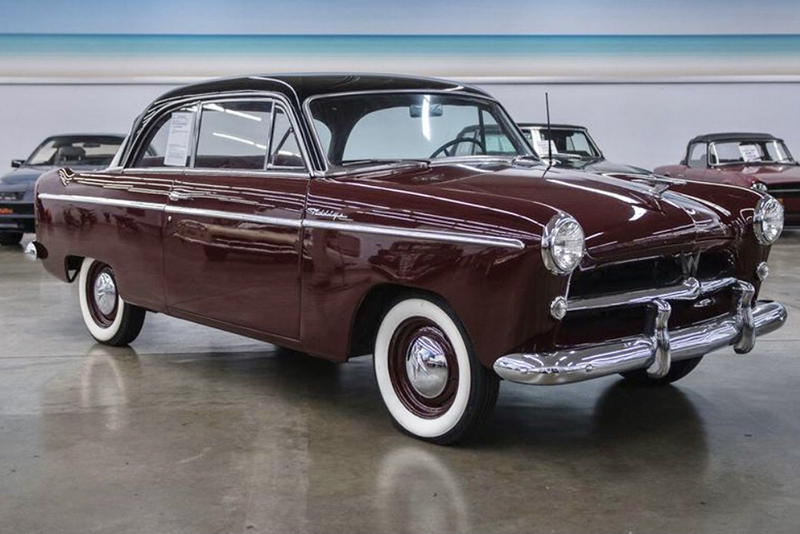
1953 Willys Aero Eagle
History
Built with monocoque construction, the clean-lined Aero Willys was practical in size and one of the best-riding compacts of the early 50s., Unfortunately, the price was too high to wean many buyers away from Ford, Chevy, and Plymouth models, even the cheaper ones. The Aero-Eagle two-door hardtop was the costliest and most luxurious of the various models offered, which also included Wing, Lark, Ace, and Falcon two- and four-door sedans.
Kaiser acquired Willys in 1954, and the 226-cid Kaiser six was offered as an optional alternative to the Willys F-head four and 161-cid six. The Custom designation was introduced that year to denote an exterior or continental style spare tire mount., Pluses of the 1952-1954 Willys Aero-Eagle: Nice looks, Fine ride/handling combination, 226-cid models have good performance, Reasonable economy even today, Production of the 1953 Willys Aero-Eagle: Just 7,018 cars. How many survive today??? A handful???
The Willys Aero was a line of passenger cars manufactured first by Willys-Overland and later by Kaiser-Willys Corporation from 1952 through 1955. The father of the Aero was Clyde Paton, former engineer for Packard Motor Car Company . The Eagle and Lark models were built from 1952 to 1954. A Wing model was available only in 1952, a Falcon model in 1953, and a taxicab in very limited production in 1953 and 1954. The Ace was the only model built through all U. S. production. 1955 saw two new models, the two- and four-door Ace sedans (renamed Custom shortly into the production run) and two-door hardtop Bermuda.
Production in the U.S.A. ended that year as Henry J. Kaiser decided to give up the Kaiser and Willys Aero lines and concentrate solely on Jeeps. A total of 91,377 Aeros were built in Toledo.
Production was moved to Brazil from 1960 to 1971 with Aero, 2600, Itamaraty, and Executivo models. (The Willys Aero was sold through Ford do Brasil dealerships until production ceased where the US Ford Maverick replaced the Aero.) 116,967 were built.
Toledo-built models were available with four engine options: the F4-134 Hurricane, the L6-161 Lightning, the F6-161 Hurricane; and, after the Kaiser firm purchased the Willys firm, the L6-226 Super Hurricane from the Kaiser car line. The four-cylinder was used only in Aero Lark and was only exported., For 1952, the model names Eagle, Wing and Ace were used for cars that had the six-cylinder F-head Hurricane engine and the Aero-Lark had the six-cylinder flathead Lightning engine.
All 1952s had a two-piece split windshield. Eagles and Aces had a three-piece wraparound rear window, while the larks and Wings had a smaller one-piece rear window., Owners of the 1952 model tended to buy the cars for their good fuel economy. They tended to find acceleration to be very good unsurprising given the cars had the best power-to-weight ratio among US production cars. The primary complaint from two-door owners was the difficulty of access to the rear seat.
Many felt the cars cost too much, even if they were a bargain on performance for cost grounds. Floyd Clymer noted the car was quite capable of comfortably cruising at highway speeds of 80-90 miles per hour.
This continued for 1953 except the Wing was dropped and replaced by the Aero-Falcon, which had the six-cylinder Lightning engine.
All 1953s were available as two-door or four-door sedans except the Eagle, which was a two-door hardtop. One-piece windshields were given to the Aces and the Eagles, but the Lark and Falcon retained the split windshield. Rear windows remained the same. Export Larks were available with the four-cylinder F-head engine. Dual-range Hydramatic transmissions were bought from GM and were optional in Aces and Eagles beginning in August 1953,



1953 Willys Aero Falcon Bermuda
I had a ’54 Aero Lark for many years with the “Willys” F-head six. They had a problem with the block cracking between the cylinders and the exhaust valve seats. New blocks were available but since they were also used in the Kaiser Darrin, they were too expensive for us Willys folks. Any time you told someone you had a ’54 Willys they imagined it was a Jeep or a boxy wagon. Great little economical car if you didn’t mind the cracked blocks.
in January 1952–10 years after the last Willys automobile had rolled off the line–the company introduced its beautiful new Aero Willys. Designed by Clyde Paton and Phil Wright, the unibody cars rode a 108-inch wheelbase, longer than the Rambler and Henry J, but smaller than any model by the Big Three. Careful engineering provided a smooth ride and exceptional handling. With clean styling and a powerful yet economical drivetrain, the Aero was quite a nice package. The car’s handsome profile flowed smoothly from front to rear, interrupted only by rear fender wings with inset taillamps. Up front, a thick chrome bar topped by a large “W” nestled in a large grille cavity. A stylized plane served as a hood ornament.
Popular Science January 1952
The lineup consisted of two-door sedans in Aero-Lark, Aero-Wing and Aero-Ace trim, plus an Aero-Eagle hardtop coupe. In the base Aero Lark series, power was provided by a Willys 75hp Lightning straight-six flathead, while the upscale Wing, Ace and Eagle models used the 90hp Hurricane F-head six-cylinder. A hardtop-style roof and wraparound rear window distinguished the Ace, while the more conservative Aero-Larks and Aero-Wings had wider C-pillars and a narrower rear window. The Willys was roomy inside, measuring 61 inches wide and easily accommodating six passengers. Boasting the most horsepower per pound of weight of any U.S. car, by the standard of that era, its acceleration was very good. Willys said its new cars were capable of “Brilliant Performance,” claiming that up to 35 MPG and 0-60 times of 17.5 seconds were possible, though Popular Science reported 0-60 in 20.5 seconds. Road testers, however, were uniformly enthusiastic about the new Willys, especially about the engine’s smoothness and power. “The car walked right on past 60 to 70, then 80 and pegged its speed at 86 MPH in direct drive… In overdrive, the car did a little better: 89 MPH. It cruised beautifully at 75,” said Popular Science, adding, “The braking was exceptional. From an indicated 86 MPH, the car came to a full stop in 156 feet.”



